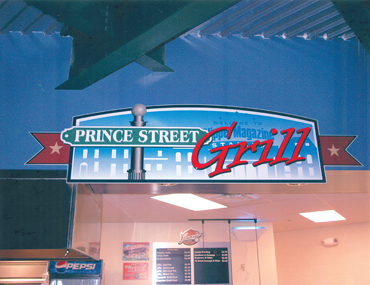Vehicles + Vinyl
Stick With It
A look at adhesives used with pressure-sensitive vinyls
Published
17 years agoon

How often have you taken a sample of pressure-sensitive adhesive (PSA) from your local rep, inspected it and peeled the liner back to feel the adhesive’s tackiness? And, whether or not you care to admit it, you’ve probably pulled the sample close to your nose for a sniff.
I have no idea why we do that, but abundant information describes the adhesives that trigger those olfactory receptors (no, this is not an anatomy lesson). We’re going to learn about vinyl’s most important component — its adhesive. This month, we’ll explore different PSA-vinyl adhesive types, and how they can impact your sign or graphic applications. So, let’s get sticky!
What makes it stick anyway?
I’m not a chemical engineer, but I somewhat know what makes vinyl stick. Most vinyl adhesives comprise synthetic materials made from myriad chemical compounds that, when melded together, form an acrylic resin. Obviously, manufacturers’ formulae vary, but generally, depending upon the adhesive’s intended use, solvents or water break down the chemical. Differing dispersion techniques allow adhesives to stick better to some sub-strates and surfaces than others.
Several dispersion techniques allow adhesives to bond more effectively with some substrates than others. I won’t dwell on this topic — I already feel my eyelids getting heavy. Instead, let’s examine how adhesives’ chemical makeups impact the finished product.
AdvertisementWater- vs. solvent-based
Again, adhesives are water- or solvent-soluble. To borrow a co-worker’s analogy, consider adding sugar to a glass of iced tea (yes, fellow Southerners, you have to add your own sugar north of the Mason-Dixon line). Notice that sugar settles to the bottom and doesn’t mix well. Thus, sugar doesn’t sweeten iced tea as well because it hasn’t mixed well.
In contrast, if, while enjoying a relaxing cup of hot tea, you add that same sugar, you’ll notice it dissolves very easily, and more sugar can be readily added. Think of waterbased adhesives as the iced-tea mixture, and solvent -based adhesives as hot tea. Adding more adhesive components to the solvent mixture creates a structurally stronger adhesive.
By now, you may be asking, “How do I know which adhesive I’m using?” As I always tell my seminar audiences, read up. Always check the manufacturer’s product bulletins and technical sheets before purchasing a film. You may see the adhesive listed as an “acrylic” or “acrylate.” A word to the wise – if the adhesive isn’t noted as “solvent,” chances are it’s waterbased.
That said, please don’t discount waterbased adhesives. Because manufacturers are using an essentially free material to dilute the adhesive, they provide a very economical film option. Also, using water as the mixing agent yields a more environmentally friendly film, which pleases the EPA.
Typically, an economical film has a waterbased adhesive. These films are ideal for indoor graphics and short- to medium-term, outdoor graphics. Also, because of their economy, waterbased adhesives are typically added to monomeric (single chains of polyester molecules), calendered films. Applying this type of adhesive to an expensive, cast-film facestock wouldn’t make sense. Waterbased adhesives are produced in removable and permanent varieties (more on this later).
AdvertisementWaterbased adhesives are com-monly incorporated into films used in the POP market, where high volume and fast turnaround rule. Consider how often soft-drink kiosks change in your local grocery store.
In certain municipalities, officials specify these films for public buildings, museums and convention centers. They don’t want materials that spread a fire’s flames. This type of adhesive allows the film to self-extinguish. Outdoors, such films are commonly used for short-term billboards and other graphics made for economy-minded clients.
When installing films with waterbased adhesives, always avoid wet applications. The application fluid impedes the adhesive and retards set-up time. Anyone who’s attempted a wet application, where the vinyl stays on the premask and not on the substrate, will understand.
Back to the tea analogy. Manu-facturers build a stronger adhesive by diluting the mixture with solvents. Solvent-based adhesives are always used to produce medium- and long-term, calendered, ultra-calendered and cast graphic films. Ideal applications include architectural signage and fleet programs, but they offer broad capabilities.
But what does this really mean for our applications? First, we gain more adhesive options. Beyond permanent and removable materials, repositionable films are used to output vehicle wraps. Solvent-based adhesives also enable wet applications when necessary, such as glass or polycarbonate. They also allow higher resistance to chemicals, such as cleaning agents and other solvents.
Advertisement
Power talk
Let’s examine the strength of the two types of chemical adhesives. An adhesive’s power determines whether it’s permanent or removable. Don’t be confused — regardless of the variation, only two adhesive types exist in our market.
Several tests determine an adhesive’s power, but the most important affixes the film to various substrates. Then, a device that peels away the films measures the force required to remove it from the substrate. These tests usually express the result in pounds per square inch (lbs./sq. in.). Measuring the mechanical force required to remove a film from its substrate quantifies a film’s strength.
A clean getaway
Removable adhesives don’t usually exceed an adhesive power of 2.5 lbs./sq. in. This allows film removal from the substrate by merely picking at an edge with your finger and pulling gently to remove it.
Also, they can be extricated easily without leaving residue — this is crucial when supplying graphics to customers who frequently change their advertising message, or if leaving the surface below the graphics clean is a priority. If you plan to use a removable adhesive over corrugations or rivets, don’t. They simply lack the strength to conform.
Contrastingly, removable-adhesive films are ideal for applications with flexible lifespans that require smooth removal. Transit authorities usually mandate that graphics removals from buses, subway cars and transit stops leave no residue. No one wants to pay for residue removal, and these graphics change frequently.
Floor graphics are another perfect application for removable films. Your customers will thank you when, at removal time, they don’t have to worry about scraping adhesive from the floor.
Lasting power
Let’s examine what makes graphics last “forever.” When fabricating long-term graphics, only permanent adhesives suffice. A permanent PSA film offers an adhesive power of at least 4 lbs./sq. in. or more. With this strength level, you can’t remove the film with your finger.
Rather, you’ll probably need a heat gun or torch to warm the film and break its bond to the substrate. If you’re lucky, you’ll get to play with adhesive removers that remove leftover adhesive. However, this adhesive power allows attractive, durable graphics.
Permanent adhesives, coupled with conformable films, conform to rivets and corrugations. These are perfect for full-vehicle wraps. Without this adhesive integrity, the film simply releases from those complex surfaces. When purchasing vehicle wraps, you’ll see repositionable and positionable adhesives – make no mistake, these are still permanent adhesives.
With these wraps, the final, permanent bond with the substrate is delayed — for several years in some cases. This allows film applications that can be applied and promptly removed if the fabricator doesn’t like the first application. Thus, the films leave little or no residue for long periods.
Permanent adhesives are crucial to such applications as corporate signage (which, in most cases, means backlit signs), fleet programs, architectural signage and signage exposed to extreme conditions. If you know a graphic will face drastic climate changes, or will be within little Johnny’s easy reach, make sure you use a permanent adhesive.
Stick it to ’em
Hopefully, you’ve gathered a basic understanding of the best scenarios for different types of available PSA vinyls. Again, many options exist, so closely follow your manufacturer’s most current technical bulletins.
Also, educate your customers about the films and adhesives best suited to their applications. By providing such information, you’ve elevated your company beyond a shop that merely makes signs to a solution provider and information source. This will, ultimately, help forge bonds that help business relationships really stick.

SPONSORED VIDEO
Introducing the Sign Industry Podcast
The Sign Industry Podcast is a platform for every sign person out there — from the old-timers who bent neon and hand-lettered boats to those venturing into new technologies — we want to get their stories out for everyone to hear. Come join us and listen to stories, learn tricks or techniques, and get insights of what’s to come. We are the world’s second oldest profession. The folks who started the world’s oldest profession needed a sign.
You may like

Konica Minolta and FUJIFILM Business Innovation Explore Alliance

INX Promotes Three to Vice President

6 Sports Venue Signs Deserving a Standing Ovation
Subscribe

Bulletins
Get the most important news and business ideas from Signs of the Times magazine's news bulletin.
Most Popular
-

 Tip Sheet4 days ago
Tip Sheet4 days agoAlways Brand Yourself and Wear Fewer Hats — Two of April’s Sign Tips
-

 Business Management2 weeks ago
Business Management2 weeks agoWhen Should Sign Companies Hire Salespeople or Fire Customers?
-

 Real Deal5 days ago
Real Deal5 days agoA Woman Sign Company Owner Confronts a Sexist Wholesaler
-

 Women in Signs2 weeks ago
Women in Signs2 weeks ago2024 Women in Signs Award Winners Excel in Diverse Roles
-

 Benchmarks1 day ago
Benchmarks1 day ago6 Sports Venue Signs Deserving a Standing Ovation
-

 Editor's Note1 week ago
Editor's Note1 week agoWhy We Still Need the Women in Signs Award
-

 Women in Signs5 days ago
Women in Signs5 days ago2024 Women in Signs: Megan Bradley
-

 Line Time2 weeks ago
Line Time2 weeks agoOne Less Thing to Do for Sign Customers















